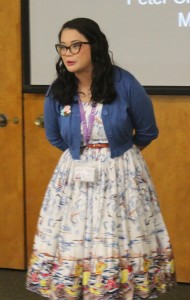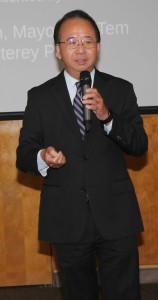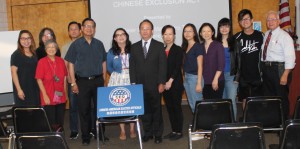Chinese Contributions to the United States of America

Katrina Lacerna, the Asian Pacific Resource Center Librarian at the Rosemead Library introduced Monterey Park Mayor Pro Tem Peter Chan to the audience on September 29th.
Peter Chan attended La Salle College in Hong Kong and University of Wisconsin. He is a member of the Monterey Park City Council and a successful business owner.

Peter Chan welcomed the audience to this special presentation on Chinese Exclusion Act. He put together a slide show that highlighted the major events of this time in history. He thanked the Rosemead Library and Los Angeles County for donating their time for this event.
He also showed a copy of Monterey Park’s Proclamation dated May 6, 2017 apologizing to the Chinese people for the Chinese Exclusion Act.
He gave a brief history on why the Chinese immigrated into the United States and moved into California.
One reason was the Opium Wars from 1839 until 1842 when the Qing Dynasty was weak. They could not support their people so many peasants left China and headed to California to join the Gold Rush from 1848 to 1852. They worked for money to send home to their families. When the Gold Rush was over on the Chinese immigrants moved around the country looking for work.
In 1861 to 1865 the Civil War was fought in America. He did not mentioned if any of the Chinese immigrants fought in this war. Each side built railroads to deliver the necessary goods to their camps. After the Civil War there was a downturn in the economy.
In 1862 to 1869 the railroads were built in America from the East Coast and the West Coach to meet in Utah. There was a great need for laborers. The Chinese joined with Americans and other immigrants to work on this project.
Mr. Chan said the white people got the best jobs but the Chinese believed the conditions in California were better then the conditions in China.
The Chinese dug ditches with people from all over the world. They helped to tunnel the tracks through the Rocky Mountains. They often placed the dynamite in the holes lowered in baskets down the hillside. They called up before the explosions so they could be pulled up. Sometimes the blast took their lives. They were willing to work harder for lower wages, which upset many of the other workers.
The Chinese people did not get sick by drinking the water. They boiled the water for tea so they were able to continue to work while other people were sick.
They also worked in the farming industry in California as well as developed the Sacramento and San Joaquin Valley.
In the 1800s they also developed laundries to wash clothes for the other residents of the neighborhood.
In 1876 to 1878 the Chinese immigrants were blamed for depressed wages and taking away job from other Americans. The Chinese were easy targets to hate because they dressed differently and did not speak English.
In 1879 California Government voted on Anti-Chinese Legislation, which was the beginning of The Chinese Exclusion Act. It has been referred to the first labor union.
On May 6, 1882 President Chester Arthur signed into law The Chinese Exclusion Act prohibiting all immigration of Chinese laborers. Our U S government did not support their rights. This law also restricted the number of immigrants from China.
On October 24, 1871 two Chinese gangs had a fight in the streets of Los Angeles. One of the members fired a shot that hit a white person. The gang members were attacked but no one was brought to justice. The Courts did not believe the Chinese witnesses.
On September 2, 1885 in Rock Springs, WY the Chinese miners were paid lower wages. The white people complained. They wanted to get rid of the Chinese in the mining fields. According to history 125 white miners attacked them and killed up to 28 Chinese. Again no white miners were ever charged since the law did not protect the Chinese.
In 1892 the Geary Act extended the Exclusion Act for another ten years. Chinese were required to carry an ID or they could be arrested and deported.
In 1902 the Exclusion Act was extended for another ten years.
In 1904 the Chinese were excluded from the American life style so they formed their own associations to protect themselves.
In 1880 the Chinese formed their own Bevelonent Association and established
Chinatown.
Other Americans did not accept them because they were different in their dress, in their life styles and they did not speak English.
Other immigrants assimilated in the American life after the first generation. It was harder for the Chinese to adjust to the American way of life.
On April 18, 1906 when the great San Francisco earthquake and fire destroyed many government offices with their records. The Chinese took advantage of this event and created “Paper Sons” and “Paper Daughters” since all of the records were destroyed.
Angel Island was established in California from 1910 until 1940 that processed approximately 1 million Chinese immigrants before they were allowed into the United States. (Editor’s note: Ellis Inland was established in New York from 1892 until 1954 that processed approximately 12 million European immigrants before they were allowed to enter the United States.)
In 1939 World War II began in Europe.
On December 7, 1941 the Japanese bombed Pearl Harbor and the United States went to war.
General Claire Chennault established the Flying Tigers on December 20, 1941. They were volunteer members of the Chinese Air Force. After Pearl Harbor the Flying Tigers fought the Japanese until July 4, 1942.
During World War II America fought in both Europe and Asia. They needed help to fight the Germans and the Japanese, who had covered over a half of China during the war.
The Magnuson Act, also known as the Chinese Exclusion Repeal Act of 1943, was an immigration legislation proposed by U.S. Representative (later Senator) Warren G. Magnuson of Washington and signed into law on December 17, 1943 in the United States.
The United States needed the Chinese-Americans to help fight in the war
so they enlisted to fight in the U S military. They usually were cooks and porters. They were not given a higher rank.
In 1943 Lt. Victor Schoon, a third generation Chinese-American enlisted in the Army Air Corps. He was thought to be European-American so he was able to become a B-17 pilot. He flew 50 successful missions over Europe. He didn’t know that a fire would rip through the Army’s archives, destroying their records of his service and denying him the “Distinguished Flying Cross Medal” he so clearly deserved. He was honorably discharged on February 7, 1944.
His nine-crew members were no longer alive to verify his record so Congress could not validate the award.
In 1960 The Civil Rights Movement helped to make life easier of all Americans and immigrants.
In 1965 President Johnson signed in Immigration and Nationality Act. This act changed the number of immigrants allowed to enter the United States from all over the world. Each country had a quota system.
The Chinese who felt they were never part of our America said that they lost four to five generations by living in Chinatown.
Now they are establishing themselves as Americans and reaching out to establish a better life for their families and themselves.
On October 8, 2012 Congressmember Judy Chu said at a ceremony honoring Lt. Victor Schoon in her El Monte Office that she submitted his record to the Congressional Record in Congress and it would be entered into the record, forever in the archives of Washington D. C. at the U. S. Capitol.
Victor Schoon, retired to San Diego until his death on September 25, 2012 at the age of 93.
Peter Chan stated the Chinese immigrants contributed so much to the United States. People need to understand our history.

Peter Chan joined with members of the Chinese American Citizens Alliance at the end of this event.
Peter Chan can be reached at the Monterey Park City Hall at 626-307-1255 or by email Pchan@montereypark.ca.gov to request his presentation on this topic at your school, service club or other events.



